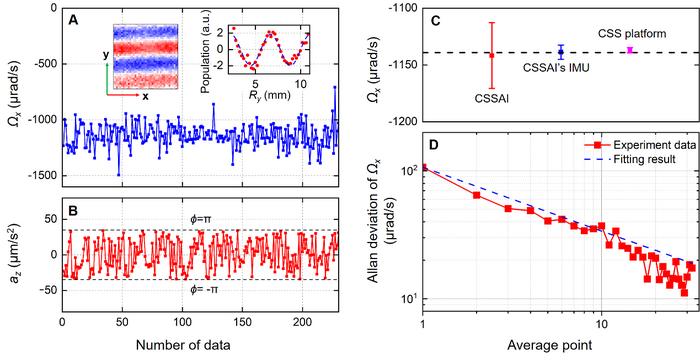Insider Brief
- China’s space-based cold atom gyroscope uses quantum interference of ultracold atoms to achieve high-precision motion sensing in orbit.
- The device leverages matter-wave interference from rubidium atoms to detect tiny changes in rotation and acceleration with exceptional sensitivity.
- Researchers optimized laser configurations to eliminate quantum decoherence effects, enabling stable and repeatable measurements in microgravity.
- Image: Rotation and acceleration measurements using the CSSAI in-orbit and (Right) Rotation comparison between the CSSAI and the classical gyroscopes of the CSS. (Science China Press)
A Chinese research team has successfully demonstrated the world’s first cold atom gyroscope operating in space, achieving rotation and acceleration measurements that could pave the way for quantum navigation systems and new tests of fundamental physics, according to the team’s official release.
As reported by Space Insider, the results, published in the National Science Review, mark a significant step in applying quantum technologies to real-world space applications. While previous efforts have relied on mechanical or optical gyroscopes, the Chinese team — led by scientists at the Chinese Academy of Sciences — used the wave-like behavior of ultracold atoms to detect motion with unprecedented precision.
This shift toward quantum inertial sensing opens a new path for spacecraft that require ultra-stable, drift-free navigation, and for physics experiments that probe Einstein’s theory of general relativity in the low-gravity, low-noise environment of orbit.
The advance also has strategic implications, as well, paving the way for quantum gyroscopes to eventually replace or complement existing systems in satellites, spacecraft, submarines and other vehicles where traditional sensors reach their limits.
A Matter-Wave Approach to Motion
The core of the technology is an atom interferometer: a quantum device that splits and recombines matter waves—in this case, clouds of rubidium atoms cooled to near absolute zero, Space Insider reports. The interference patterns that result are exquisitely sensitive to motion, providing a way to detect tiny accelerations and rotations far beyond the capability of classical sensors.
The experiment, known as the China Space Station Atom Interferometer (CSSAI), was launched in late 2022 and installed aboard the China Space Station. The payload, no larger than a microwave oven, uses only 75 watts of power. Despite its size, CSSAI achieved rotation and acceleration sensitivity levels that represent orders of magnitude improvement over Earth-based systems.
According to the team’s data, the interferometer could sense rotational changes as small as the slow spin of a coin observed from over 100 kilometers away. Its acceleration resolution is about 100,000 times more sensitive than what’s found in a typical smartphone accelerometer—enabling the detection of forces as gentle as a falling snowflake in space.
Unraveling the Shearing Problem
To reach this sensitivity, researchers had to solve a significant challenge: interference patterns in orbit are prone to distortion, a problem known as shearing fringe dephasing. These distortions can arise from small differences in the initial position or velocity of the ultracold atom clouds.
The team developed a technique to counteract these effects by identifying a specific laser beam configuration — referred to as a “magic angle” — that cancels out unwanted shifts. Using this configuration, they achieved stable rotation and acceleration readings in orbit, with a single-experiment rotation resolution of 50 micro-radians per second and an acceleration resolution of 1.0 micrometers per second squared.
Over longer periods, integrating data from multiple experiments, the rotation resolution improved to just 17 micro-radians per second. These values were then cross-checked with conventional gyroscopes aboard the station and found to match closely, validating the reliability of the quantum approach.
Implications for Navigation and Relativity
Beyond spacecraft guidance, quantum gyroscopes like CSSAI have the potential to test some of the most subtle predictions of general relativity — such as frame-dragging, the idea that massive rotating bodies slightly twist the fabric of space-time. Previous space missions, including NASA’s Gravity Probe B and Italy’s LARES, confirmed these effects but were limited by the precision of classical instruments.
The Chinese experiment, by contrast, uses the fundamental properties of quantum mechanics to bypass some of those limitations. According to Space Insider, this could allow future missions to explore areas where general relativity might break down or where new physics could emerge.
The study also included a comprehensive analysis of factors that limit accuracy in space-based atom interferometry, ranging from magnetic field variation and laser timing to imaging precision and the shape of the atom clouds themselves. One key takeaway was the importance of minimizing errors in the shearing angle, which the team identified as a primary source of systematic uncertainty.
Toward a Quantum-Enabled Space Age
The CSSAI experiment is part of a broader push by China to lead in quantum technologies in space. While Europe and the U.S. have performed microgravity quantum experiments on parabolic flights or rockets, CSSAI is reportedly the first fully operational cold atom gyroscope deployed in orbit.
This aligns with China’s larger strategy to integrate quantum communication, sensing, and eventually quantum computing capabilities into space infrastructure. Dual-use applications — scientific and strategic — are likely to follow, according to observers at Space Insider.
The study’s co-corresponding authors, Xi Chen, Jin Wang, and Mingsheng Zhan, note that this demonstration lays the groundwork for next-generation quantum inertial navigation systems that could operate independently of GPS—a crucial capability for deep-space missions or defense scenarios where satellite signals may be unavailable or jammed.
Next steps for the research team include reducing remaining error sources, scaling the technology to larger systems, and integrating cold atom sensors into more rugged platforms. The end goal is a new class of quantum-enabled instruments that can operate autonomously, precisely, and reliably—both for science and for real-world missions far from Earth.

0 Comments